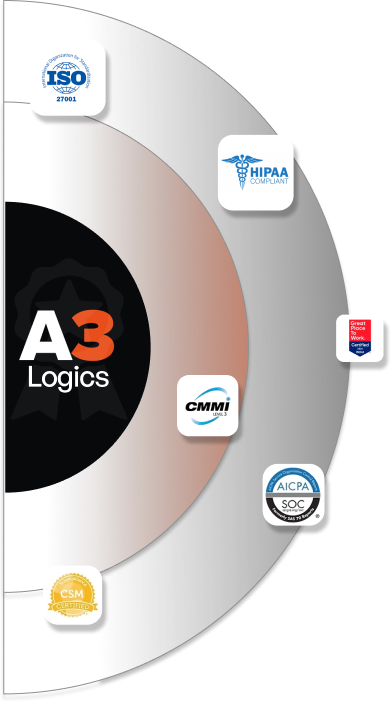As we all know the world of transportation is evolving with every passing day, computer vision made the process a complete game changer. It makes the traffic management process hassle-free in every aspect. With the help of the advanced image and video processing algorithms, you will be able to track, assess and manage the flow of the vehicles, pedestrians, and infrastructure as well through computer vision in traffic management.
So, if you are thinking about what this is all about, then you have certainly landed on the right page as we are going to discuss all the aspects about it to help you move ahead with all the clarity related to computer vision solutions in traffic management.
Table of Contents
Computer Vision in Traffic Management: A Brief Overview
Computer vision in managing traffic is a fast expanding area using modern technologies like deep learning and artificial intelligence to derive useful insights from visual data. This creative idea lets urban planners and transportation agencies make data-driven decisions, boost general efficiency, and increase commuter safety and convenience. Real-time video feed analysis allows computer vision development companies to offer a broad spectrum of solutions tackling the multifaceted issues confronting contemporary transportation systems.
Hopefully, you are clear about the aspect related to computer vision in traffic management as we below discuss the computer vision applications in detail through its use cases.
Key Market Statistics
- As per Grand view Research, the market for computer vision solutions is projected to USD 58.29 billion by 2030 .
- North America holds a significant share in computer vision market due to advanced infrastructure and technology adoption.
Use Cases of Computer Vision in Traffic Management
Below we are going to highlight the use cases of computer vision in traffic management to help you understand how it is going to benefit you significantly.
Smart Traffic Management
Computer vision in traffic management plays a crucial role in optimizing traffic flow and reducing congestion. By deploying advanced algorithms, authorities can monitor and analyze traffic patterns, detect bottlenecks, and dynamically adjust signal timings and lane configurations to minimize delays and improve overall traffic efficiency.
Vehicle Classification and Counting
Computer vision solutions in traffic management enable the accurate classification and counting of different vehicle types, such as cars, buses, trucks, and motorcycles. This data can be used to analyze traffic composition, enforce vehicle-specific regulations, and plan infrastructure improvements to accommodate the evolving needs of the transportation network.
License Plate Recognition (LPR)
Computer vision in traffic management empowers authorities to implement automated license plate recognition systems, enabling the identification and tracking of vehicles. This technology is widely used for applications like toll collection, parking management, and law enforcement, enhancing efficiency and reducing manual intervention.
Accident Detection and Emergency Management
Computer vision in managing traffic can be leveraged to detect traffic accidents and incidents in real-time, triggering immediate emergency response and facilitating the efficient coordination of first responders. This capability can significantly improve response times and minimize the impact of accidents on the overall traffic flow.
Parking Management
Computer vision solutions in traffic management enable the optimization of parking resources by detecting available spaces, monitoring occupancy rates, and guiding drivers to open spots. This not only enhances the convenience for users but also reduces the time and fuel spent searching for parking, ultimately contributing to a more sustainable transportation ecosystem.
Toll Collection Automation
Computer vision in traffic management revolutionizes the toll collection process by automating the identification and billing of vehicles, eliminating the need for manual intervention and reducing congestion at toll plazas. This technology is particularly beneficial in improving traffic flow and reducing environmental impact.
Benefits of Computer Vision in Traffic Management
Computer vision in traffic management offers a wide range of benefits that address the pressing challenges faced by transportation authorities and commuters alike. By providing real-time data and intelligent insights, these solutions enhance overall efficiency, improve safety, and contribute to a more sustainable transportation system.
Improved Traffic Flow and Reduced Congestion
Computer vision solutions in traffic management enable the optimization of traffic signals, the identification of bottlenecks, and the dynamic allocation of lane usage, leading to smoother traffic flow and reduced congestion. This, in turn, decreases travel times, fuel consumption, and environmental pollution.
Enhanced Safety and Incident Response
Computer vision in managing traffic can detect accidents, monitor traffic violations, and trigger immediate emergency response, improving overall safety for both drivers and pedestrians. This capability can significantly reduce the impact of incidents and save lives.
Efficient Parking and Toll Collection
Computer vision in traffic management revolutionizes parking management and toll collection, providing automated solutions that enhance convenience, reduce search times, and minimize environmental impact by minimizing unnecessary vehicle idling.
Data-Driven Decision Making
An artificial intelligence development company provide transportation authorities with a wealth of real-time data and analytics, enabling them to make informed decisions, plan infrastructure improvements, and optimize resource allocation based on empirical evidence.
Improved Environmental Sustainability
By reducing traffic congestion, optimizing vehicle flow, and automating toll collection and parking management, computer vision in traffic management contributes to a more sustainable transportation system, with lower emissions and a smaller environmental footprint.
Challenges and Limitations
While computer vision in traffic management offers numerous benefits, there are also challenges and limitations that must be addressed to ensure the successful implementation and widespread adoption of these technologies.
Privacy and Data Security Concerns
The deployment of computer vision solutions in traffic management raises significant concerns about privacy, as these systems involve the collection and processing of a wide range of personal data, including vehicle registration information, driver identities, and potentially even biometric data. Addressing these privacy concerns is crucial to maintaining public trust and ensuring compliance with evolving data protection regulations.
Transportation authorities and computer vision development companies must implement robust data security measures, such as encryption, access controls, and data minimization, while also maintaining transparency about data usage and providing clear opt-out options for individuals. Striking the right balance between leveraging the benefits of computer vision and safeguarding personal privacy is a key challenge that must be navigated through collaborative efforts between technology providers, policymakers, and civil society.
Technical Complexity and Integration
Implementing computer vision in traffic management is a complex endeavor that requires the seamless integration of various hardware and software components, including cameras, sensors, communication networks, and advanced analytics platforms. Ensuring that these diverse systems work together efficiently and reliably can be a significant challenge, particularly when dealing with legacy infrastructure or the need to upgrade existing systems.
Transportation authorities and computer vision development companies must carefully plan and execute the integration process, accounting for factors such as data compatibility, system interoperability, and the ongoing maintenance and support requirements. Addressing the technical complexity of these solutions is crucial to delivering the promised benefits of computer vision in traffic management without compromising system stability and performance.
Infrastructure and Funding Requirements
Deploying computer vision in traffic management often requires substantial investments in infrastructure, including the installation of cameras, sensors, and communication networks. Securing the necessary funding and resources to implement and maintain these systems can be a significant barrier, particularly for resource-constrained transportation authorities. Navigating budgetary constraints and competing priorities within the public sector can be a daunting task, and may require innovative financing models, public-private partnerships, or the leveraging of external funding sources.
Additionally, the ongoing maintenance and upgrade requirements of computer vision systems can place a significant long-term burden on transportation authorities, necessitating the careful planning and budgeting of these lifecycle costs. Overcoming the infrastructure and funding challenges is crucial to ensuring the widespread adoption and sustainability of computer vision in traffic management.
Regulatory and Legal Considerations
The use of computer vision solutions in traffic management is subject to a complex web of regulatory and legal requirements, such as data privacy laws, traffic regulations, and liability considerations. Transportation authorities and computer vision development companies must navigate these frameworks to ensure compliance and mitigate potential legal risks.
For example, data privacy regulations may impose strict limitations on the collection, storage, and use of personal data, requiring the implementation of comprehensive data governance policies. Traffic regulations may also influence the deployment and operation of computer vision systems, such as the placement of cameras or the enforcement of traffic rules. Additionally, liability considerations, such as the responsibility for accidents or system failures, must be clearly defined and addressed. Navigating these regulatory and legal complexities can be a significant challenge, requiring close collaboration between transportation authorities, legal experts, and computer vision development companies.
Ethical Concerns and Bias
Computer vision systems in traffic management have the potential to exhibit biases, either in the underlying algorithms or the training data used to develop them. These biases can lead to unfair or discriminatory outcomes, such as the disproportionate targeting of certain demographic groups or the perpetuation of existing societal biases. Addressing these ethical concerns and ensuring the equitable and unbiased application of computer vision technology is crucial to maintaining public trust and acceptance.
Transportation authorities and computer vision development companies must implement rigorous testing and validation processes, diversify their data sources and algorithms, and engage with community stakeholders to identify and mitigate potential biases. Ongoing monitoring and adjustment of these systems, as well as transparent communication about their limitations and biases, are essential to fostering public confidence in the use of computer vision in traffic management.
Future Trends & Innovations in Computer Vision for Traffic Management
The future offers interesting developments and inventions that will further improve the efficiency, safety, and sustainability of transportation systems as computer vision in traffic management develops.
Integration with Connected Vehicles and Infrastructure
More thorough and cooperative traffic management will be made possible by the combination of computer vision solutions in traffic management with developing technologies such as connected cars and smart infrastructure. Real-time data exchange, predictive analytics, and the creation of sophisticated cooperative systems will result from this integration.
Autonomous and Cooperative Traffic Management
The evolution of autonomous and cooperative traffic management systems will be significantly influenced by computer vision in managing traffic. These systems will be able to dynamically change traffic signals, direct cars, and coordinate the movement of both human-driven and autonomous vehicles by means of real-time data analysis and traffic pattern prediction.
Multimodal Transportation Integration
Computer vision in traffic management will continue to improve to embrace the management of numerous forms of transportation, including vehicles, buses, trains, bicycles, and pedestrians. This integration will allow a more complete and efficient transportation system, hence meeting the various requirements of passengers.
Artificial Intelligence and Machine Learning Advancements
Continued advancements in artificial intelligence and machine learning will empower computer vision development company to create more sophisticated algorithms capable of accurately detecting, classifying, and predicting complex traffic patterns. This will lead to increasingly intelligent and adaptive traffic management systems.
Sustainability and Environmental Considerations
As the global focus on environmental sustainability grows, computer vision in traffic management will play a crucial role in developing solutions that reduce emissions, optimize energy consumption, and promote the use of eco-friendly transportation modes, contributing to a greener and more sustainable transportation system.
Final Thoughts
Hopefully you are clear about all the aspects related to computer vision in traffic management. This approach has completely changed the way transportation authorities and urban planners approach all the challenges they are facing on a regular basis for the mobility needs. It helps you leverage the power of advanced image and video processing that makes the job a lot easier and effective. So, if you are thinking about making the post out of computer vision solutions in traffic management, then it is important that you take assistance from the experts in the business. It will certainly pave the way for benefits like data-driven decision-making, improved safety, and enhanced overall efficiency. If you are looking for experts in the business to help you with the same, then you can always connect with A3Logics.








